Rainbow Six: Vegas: A Performance Analysis
by Josh Venning on December 25, 2006 6:00 AM EST- Posted in
- Gaming
Graphics Settings
Rainbow Six: Vegas as we mentioned came with a lot fewer bugs and less clunkiness in the interface than the previous Splinter Cell: Double Agent we reviewed. We didn't experience any of the crashing problems with certain hardware when changing settings and we didn't have to restart the game constantly to get some settings to change. Also, loading and exiting a game to the menu took much less time which made our testing much easier - something we were very thankful for after our negative experience with the Double Agent interface.
The graphics quality settings for Vegas are a lot more straightforward than with Double Agent as well, while still offering control over a few basic settings. Some gamers might have liked more control over specific graphics options, but unfortunately they are out of luck. Still, some control is better than none, and here are the options we have available.
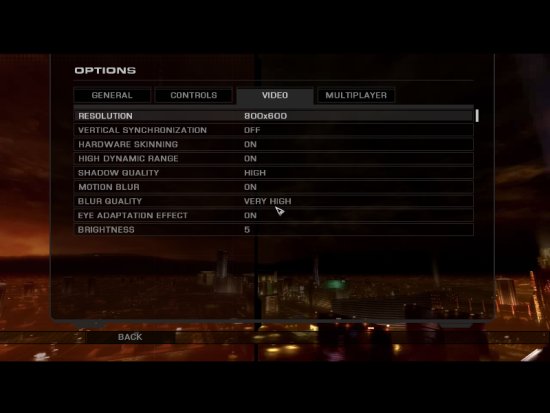
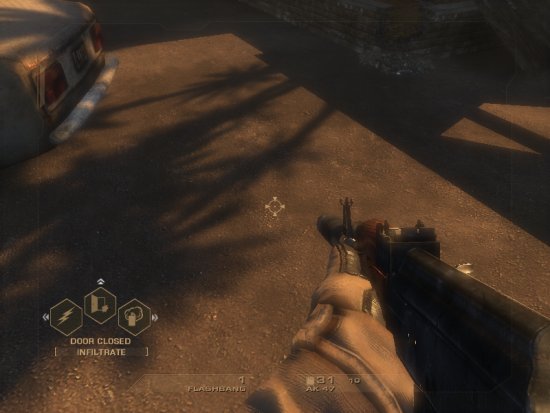
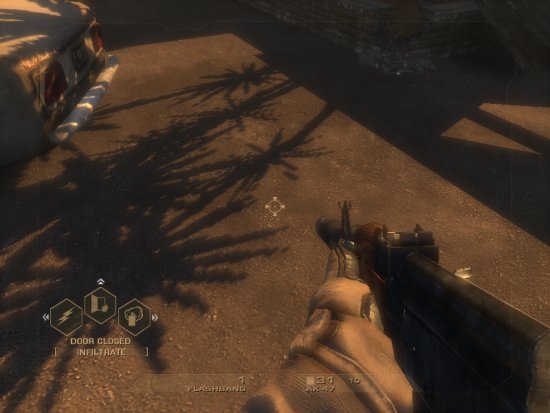
As with Double Agent, we tested Rainbow Six: Vegas at two different quality settings: one with the graphics settings at their highest, and one at lower quality settings for the lower-end cards. We only tested lower-end and midrange cards at the low quality settings, as they were the only ones that could really benefit from the extra performance. Also, the highest resolution available in the game menu is 1600x1200, but even for those with displays capable of higher resolutions, running Vegas smoothly at this resolution with the settings on highest quality will need a powerful graphics solution - something more along the lines of an 8800 rather than a 7900 GTX or X1950 XTX.
When testing at the highest quality settings, each setting was turned "on" or to the highest option available. Conversely, with the lower quality settings, we turned everything to "off" or to their lowest setting, with the exception of hardware skinning. We found this setting didn't cause much of a performance hit on our benchmark when enabled, so we left it on for all the tests. (Note that this might not be the case in other parts of the game where there are lots of characters in the scene, and turning hardware skinning off is suggested to improve gameplay performance if necessary.)
We found that with Rainbow Six: Vegas, there wasn't as much of a performance gain as we would have liked with all of the quality settings at their lowest, but we also didn't notice much difference with the settings all off, aside from the most obvious shadow effects. The game is still enjoyable with the lower quality settings, and even at a resolution of 800x600 it still looks good. The lack of an in-game option for selecting widescreen resolutions is unfortunate, but luckily some enterprising souls have created a hack available at the WSGF for the interested.
The Benchmark
Our benchmark was suggested to us by Ubisoft and it's basically an average FPS of looking out of the window on the first helicopter ride over a cityscape in Mexico. The game has no quicksave or save options, only a checkpoint system that lets you load a checkpoint as you progress in the game. There was no timedemo function to record a demo so we used FRAPS to benchmark the game. This is unfortunate because it means we can't test how the game performs during firefights, which are more graphically intensive than the helicopter ride. We can get a general idea of overall game performance, however, taking into account our benchmark results.
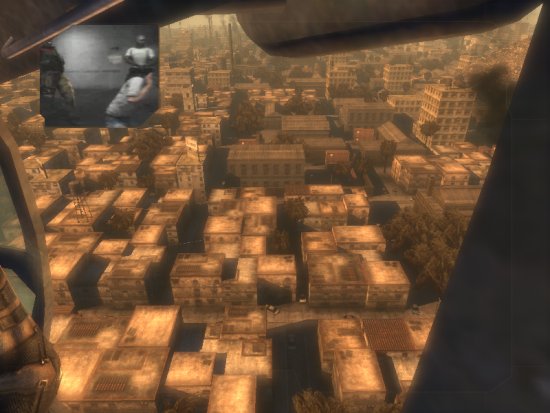
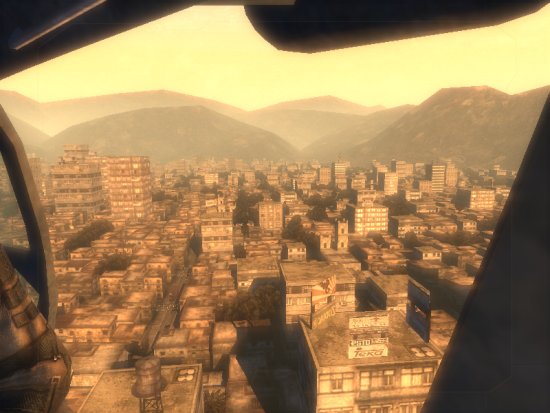
The cityscape in this first helicopter ride is impressive, with individual buildings stretching far to the horizon and large mountains looming over them in the distance. Smoke billows out of smokestacks, and some skyscrapers jut out higher than the others, while the helicopter's shadow is cast realistically further and closer on the buildings as you approach the drop-off point.
Because there aren't really any characters in the scene we used for our benchmark, the frame rate we will see in our tests will be a little higher than what we would expect during much of the gameplay of RSV. You can expect performance to decrease by as much as 30% or more with multiple enemies and your teammates all fighting in a scene. This makes things difficult as the action in the game can be very fast paced, and finding a target and hitting him accurately and quickly is sometimes vital to your survival.
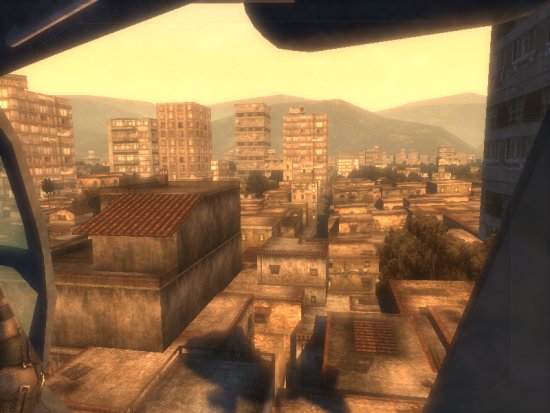
Rainbow Six: Vegas as we mentioned came with a lot fewer bugs and less clunkiness in the interface than the previous Splinter Cell: Double Agent we reviewed. We didn't experience any of the crashing problems with certain hardware when changing settings and we didn't have to restart the game constantly to get some settings to change. Also, loading and exiting a game to the menu took much less time which made our testing much easier - something we were very thankful for after our negative experience with the Double Agent interface.
The graphics quality settings for Vegas are a lot more straightforward than with Double Agent as well, while still offering control over a few basic settings. Some gamers might have liked more control over specific graphics options, but unfortunately they are out of luck. Still, some control is better than none, and here are the options we have available.

- Hardware Skinning: on/off
- High Dynamic Range: on/off
- Shadow Quality: very low/high
- Motion Blur: on/off
- Blur Quality: very low/very high
- Eye Adaptation Effect: on/off


As with Double Agent, we tested Rainbow Six: Vegas at two different quality settings: one with the graphics settings at their highest, and one at lower quality settings for the lower-end cards. We only tested lower-end and midrange cards at the low quality settings, as they were the only ones that could really benefit from the extra performance. Also, the highest resolution available in the game menu is 1600x1200, but even for those with displays capable of higher resolutions, running Vegas smoothly at this resolution with the settings on highest quality will need a powerful graphics solution - something more along the lines of an 8800 rather than a 7900 GTX or X1950 XTX.
When testing at the highest quality settings, each setting was turned "on" or to the highest option available. Conversely, with the lower quality settings, we turned everything to "off" or to their lowest setting, with the exception of hardware skinning. We found this setting didn't cause much of a performance hit on our benchmark when enabled, so we left it on for all the tests. (Note that this might not be the case in other parts of the game where there are lots of characters in the scene, and turning hardware skinning off is suggested to improve gameplay performance if necessary.)
We found that with Rainbow Six: Vegas, there wasn't as much of a performance gain as we would have liked with all of the quality settings at their lowest, but we also didn't notice much difference with the settings all off, aside from the most obvious shadow effects. The game is still enjoyable with the lower quality settings, and even at a resolution of 800x600 it still looks good. The lack of an in-game option for selecting widescreen resolutions is unfortunate, but luckily some enterprising souls have created a hack available at the WSGF for the interested.
The Benchmark
Our benchmark was suggested to us by Ubisoft and it's basically an average FPS of looking out of the window on the first helicopter ride over a cityscape in Mexico. The game has no quicksave or save options, only a checkpoint system that lets you load a checkpoint as you progress in the game. There was no timedemo function to record a demo so we used FRAPS to benchmark the game. This is unfortunate because it means we can't test how the game performs during firefights, which are more graphically intensive than the helicopter ride. We can get a general idea of overall game performance, however, taking into account our benchmark results.


The cityscape in this first helicopter ride is impressive, with individual buildings stretching far to the horizon and large mountains looming over them in the distance. Smoke billows out of smokestacks, and some skyscrapers jut out higher than the others, while the helicopter's shadow is cast realistically further and closer on the buildings as you approach the drop-off point.
Because there aren't really any characters in the scene we used for our benchmark, the frame rate we will see in our tests will be a little higher than what we would expect during much of the gameplay of RSV. You can expect performance to decrease by as much as 30% or more with multiple enemies and your teammates all fighting in a scene. This makes things difficult as the action in the game can be very fast paced, and finding a target and hitting him accurately and quickly is sometimes vital to your survival.











32 Comments
View All Comments
100proof - Thursday, December 28, 2006 - link
Matching statistics to the GamerID alone is useless. So why include the GamerID at all? Is other information related to a Ubisoft GamerID account being shared? birthdate? gender?Anandtech will you investigate this?
BronxBartoni - Tuesday, December 26, 2006 - link
I would really have loved to see the differences, if any, between single and multi core setups.poohbear - Tuesday, December 26, 2006 - link
thanks for the review anandtech, many of us are interested in new graphics engines and how they perform w/ current hardware.:)unclebud - Tuesday, December 26, 2006 - link
"I think the point Anandtech was trying to make is that they hope the performance gap can be reduced somewhat with driver/game updates."yeah, it hurts them so bad to admit it... just look at their past reviews in video for the absolute proof.
i bet if they had their way, amd + ati would have never happened. they probably have nightmares every night about it? just my opinion/observation. the site owner needs to come back and review more! i miss his articles! augh!
CrystalBay - Tuesday, December 26, 2006 - link
Go Sierra, never give in. You Rock Forever, Keep on patchin...BikeDude - Monday, December 25, 2006 - link
I don't care about 1600x1200 running full blast with all the settings enabled.Which cards will allow me to run this game at 2560x1600 using reasonable settings? (reasonable=good fps without tangos turning into stick figures)
I have a 7800GTX now... Time to upgrade?
VooDooAddict - Tuesday, December 26, 2006 - link
If you want to run at 2560x1600 then expect to be upgrading to the leading edge frequently. 8800GTX would be a good buy for you if you really want to run at 2560x1600.However, if you run at 1280x800 you'll be at a perfect scaling for that 2560x1600 monitor. (I'm assuming you have the lovely Dell 30") 1280x800 will still look great when it's running smoothly on your 7800GTX.
Spoelie - Monday, December 25, 2006 - link
yesJodiuh - Monday, December 25, 2006 - link
1. Instead of using the "suggested" scene for benching and telling us to expect worse perf, why not take a look at the most stressful scenarios?2. Would you say there might be more perf/better compat for 88's using the newer 97.02's...97.44's?
3. Are these "ports" running better on ATI because they were deved mainly for 360? Thankfully PS3's out w/ NV inside then?
ariafrost - Monday, December 25, 2006 - link
Looks like with my X850XT overclocked I may be able to run RSV at 1440x900... albeit with medium settings and the widescreen hack from WSGF.Graphics performance can only improve as the Unreal Engine 3 is tweaked/optimized. I wouldn't despair quite yet :P